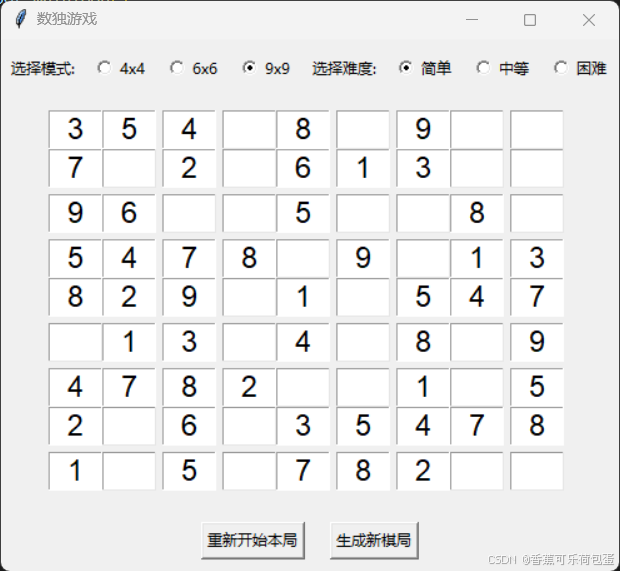数独游戏难度模式解析
在数独游戏中,难度通常由已知数字(提示数)的数量决定。难度越高,已知数字越少,玩家需要推理的步骤越多。以下是不同模式下的算法区别和核心代码解析。

文章目录
- 数独游戏难度模式解析
- 1. **难度模式配置**
- **1.1 难度与移除数量的关系**
- **1.2 难度选择界面**
- 2. **核心算法解析**
- **2.1 数独生成算法**
- **2.2 数字移除算法**
- 3. **完整代码在资源中可以下载**
- 4. **总结**
1. 难度模式配置
我们定义了三种难度模式:
- 简单模式:提示数字较多,玩家容易完成。
- 中等模式:提示数字适中,需要一定的推理能力。
- 困难模式:提示数字较少,需要较强的逻辑推理。
1.1 难度与移除数量的关系
- 简单模式:移除较少数字,保留较多提示。
- 中等模式:移除中等数量数字,提示适中。
- 困难模式:移除较多数字,提示较少。
MODE_CONFIG = {"9x9": {"base": 3, "remove_count": {"easy": 30, "medium": 40, "hard": 50}, "size": 9}, # 9x9棋盘,数字范围1-9"6x6": {"base": 2, "remove_count": {"easy": 15, "medium": 20, "hard": 25}, "size": 6}, # 6x6棋盘,数字范围1-6"4x4": {"base": 2, "remove_count": {"easy": 5, "medium": 8, "hard": 10}, "size": 4} # 4x4棋盘,数字范围1-4
}
1.2 难度选择界面
我们为难度模式添加了选择界面,用户可以选择不同的难度:
def create_difficulty_selection(self):# 创建难度选择区域self.difficulty_frame = tk.Frame(self.root)self.difficulty_frame.grid(row=0, column=1, pady=10)tk.Label(self.difficulty_frame, text="选择难度:").pack(side="left", padx=5)self.difficulty_var = tk.StringVar(value="easy")for difficulty in ["easy", "medium", "hard"]:tk.Radiobutton(self.difficulty_frame, text=self.DIFFICULTY_LABELS[difficulty], variable=self.difficulty_var, value=difficulty, command=self.update_difficulty).pack(side="left", padx=5)
2. 核心算法解析
2.1 数独生成算法
数独生成算法基于 拉丁方阵(Latin Square) 的概念,通过以下步骤生成:
- 模式函数:用于生成数独的初始填充。
- 随机化:通过随机化行、列和数字,确保生成的数独是随机的。
- 移除数字:根据难度设置移除一定数量的数字,生成题目。
def pattern(r, c): return (base * (r % base) + r // base + c) % sidefrom random import sampledef shuffle(s): return sample(s, len(s))rBase = range(base)
rows = [g * base + r for g in shuffle(rBase) for r in shuffle(rBase)]
cols = [g * base + c for g in shuffle(rBase) for c in shuffle(rBase)]
nums = shuffle(range(1, size + 1)) # 数字范围根据棋盘大小调整# 创建棋盘时使用正确的尺寸
board = [[0 for _ in range(side)] for _ in range(side)]# 填充棋盘
for r in range(side):for c in range(side):board[r][c] = nums[pattern(r, c)]
2.2 数字移除算法
数字移除是根据难度设置的参数进行的,确保不会移除所有数字,并且不会超出棋盘范围:
# 移除部分数字,生成题目
squares = side * side
# 确保不会尝试移除超过可用数量的数字
remove_count = min(remove_count, squares - self.MIN_REMOVE_COUNT) # 至少保留一个数字# 安全地随机移除数字
available_positions = [(r, c) for r in range(side) for c in range(side) if r < side and c < side]
if available_positions:# 确保至少保留一个数字safe_remove_count = min(remove_count, len(available_positions))for r, c in sample(available_positions, safe_remove_count):if r < side and c < side: # 再次检查边界board[r][c] = 0
3. 完整代码在资源中可以下载
以下是包含难度模式的部分代码:
class SudokuGame:# 常量定义CELL_WIDTH = 3CELL_FONT = ('Arial', 18)ORIGINAL_COLOR = 'black'PLAYER_COLOR = 'blue'BG_COLOR = 'white'READONLY_BG_COLOR = 'lightgray'MIN_REMOVE_COUNT = 1 # 至少保留一个数字MODE_CONFIG = {"9x9": {"base": 3, "remove_count": {"easy": 30, "medium": 40, "hard": 50}, "size": 9}, # 9x9棋盘,数字范围1-9"6x6": {"base": 2, "remove_count": {"easy": 15, "medium": 20, "hard": 25}, "size": 6}, # 6x6棋盘,数字范围1-6"4x4": {"base": 2, "remove_count": {"easy": 5, "medium": 8, "hard": 10}, "size": 4} # 4x4棋盘,数字范围1-4}DIFFICULTY_LABELS = {"easy": "简单","medium": "中等","hard": "困难"}def __init__(self, root):self.root = rootself.root.title("数独游戏")self.board = []self.original = []self.entries = [[None for _ in range(9)] for _ in range(9)]self.mode = "9x9" # 默认模式改为9x9self.difficulty = "easy" # 默认难度self.create_mode_selection()self.create_difficulty_selection()self.create_widgets()self.generate_sudoku() # 默认生成9x9棋盘和棋局def create_mode_selection(self):# 创建模式选择区域self.mode_frame = tk.Frame(self.root)self.mode_frame.grid(row=0, column=0, pady=10)tk.Label(self.mode_frame, text="选择模式:").pack(side="left", padx=5)self.mode_var = tk.StringVar(value="9x9")modes = ["4x4", "6x6", "9x9"]for mode in modes:tk.Radiobutton(self.mode_frame, text=mode, variable=self.mode_var, value=mode, command=self.update_mode).pack(side="left", padx=5)def create_difficulty_selection(self):# 创建难度选择区域self.difficulty_frame = tk.Frame(self.root)self.difficulty_frame.grid(row=0, column=1, pady=10)tk.Label(self.difficulty_frame, text="选择难度:").pack(side="left", padx=5)self.difficulty_var = tk.StringVar(value="easy")for difficulty in ["easy", "medium", "hard"]:tk.Radiobutton(self.difficulty_frame, text=self.DIFFICULTY_LABELS[difficulty], variable=self.difficulty_var, value=difficulty, command=self.update_difficulty).pack(side="left", padx=5)def update_mode(self):# 更新模式self.mode = self.mode_var.get()def update_difficulty(self):# 更新难度self.difficulty = self.difficulty_var.get()def clear_board(self):# 清理现有的输入框for row in range(9):for col in range(9):if self.entries[row][col]:self.entries[row][col].destroy()self.entries[row][col] = Nonedef create_widgets(self):# 创建数独棋盘self.frame = tk.Frame(self.root)self.frame.grid(row=1, column=0, padx=10, pady=10, columnspan=2)# 根据模式设置棋盘大小config = self.MODE_CONFIG.get(self.mode, self.MODE_CONFIG["9x9"])size = config["size"]for row in range(size):for col in range(size):entry = tk.Entry(self.frame, width=self.CELL_WIDTH, font=self.CELL_FONT, justify='center')entry.grid(row=row, column=col, padx=(0 if col % 3 != 2 else 5),pady=(0 if row % 3 != 2 else 5))self.entries[row][col] = entry# 按钮self.btn_frame = tk.Frame(self.root)self.btn_frame.grid(row=2, column=0, pady=10, columnspan=2)self.reset_button = tk.Button(self.btn_frame, text="重新开始本局", command=self.reset_board)self.reset_button.pack(side="left", padx=10)self.new_button = tk.Button(self.btn_frame, text="生成新棋局", command=self.generate_sudoku)self.new_button.pack(side="left", padx=10)def generate_sudoku(self):# 根据选择的模式和难度生成数独config = self.MODE_CONFIG.get(self.mode, self.MODE_CONFIG["9x9"])base = config["base"]remove_count = config["remove_count"][self.difficulty]size = config["size"]side = size # 棋盘边长等于sizedef pattern(r, c): return (base * (r % base) + r // base + c) % sidefrom random import sampledef shuffle(s): return sample(s, len(s))rBase = range(base)rows = [g * base + r for g in shuffle(rBase) for r in shuffle(rBase)]cols = [g * base + c for g in shuffle(rBase) for c in shuffle(rBase)]nums = shuffle(range(1, size + 1)) # 数字范围根据棋盘大小调整# 创建棋盘时使用正确的尺寸board = [[0 for _ in range(side)] for _ in range(side)]# 填充棋盘for r in range(side):for c in range(side):board[r][c] = nums[pattern(r, c)]# 移除部分数字,生成题目squares = side * side# 确保不会尝试移除超过可用数量的数字remove_count = min(remove_count, squares - self.MIN_REMOVE_COUNT) # 至少保留一个数字# 安全地随机移除数字available_positions = [(r, c) for r in range(side) for c in range(side) if r < side and c < side]if available_positions:# 确保至少保留一个数字safe_remove_count = min(remove_count, len(available_positions))for r, c in sample(available_positions, safe_remove_count):if r < side and c < side: # 再次检查边界board[r][c] = 0# 清空未使用区域self.clear_board()# 重新创建对应当前模式的输入框# 使用安全的size值current_size = config["size"]for row in range(current_size):for col in range(current_size):# 确保不会越界访问if row < len(self.entries) and col < len(self.entries[row]):entry = tk.Entry(self.frame, width=self.CELL_WIDTH, font=self.CELL_FONT, justify='center')entry.grid(row=row, column=col, padx=(0 if col % 3 != 2 else 5),pady=(0 if row % 3 != 2 else 5))entry.bind("<Key>", self.on_key)self.entries[row][col] = entryself.board = boardself.original = copy.deepcopy(board)self.update_gui()def update_gui(self):# 根据模式更新GUIconfig = self.MODE_CONFIG.get(self.mode, self.MODE_CONFIG["9x9"])size = config["base"] ** 2# 确保board已初始化if not self.board:returnfor row in range(size):for col in range(size):val = 0# 安全访问board元素if row < len(self.board) and col < len(self.board[row]):val = self.board[row][col]entry = self.entries[row][col]if entry:entry.delete(0, tk.END)# 安全访问board元素if row < len(self.board) and col < len(self.board[row]):val = self.board[row][col]if val != 0:entry.insert(0, str(val))entry.config(fg=self.ORIGINAL_COLOR, readonlybackground=self.READONLY_BG_COLOR)entry.bind("<Key>", lambda e: "break") # 不可编辑原始数字else:entry.config(fg=self.PLAYER_COLOR, bg=self.BG_COLOR)entry.bind("<Key>", self.on_key)def on_key(self, event):widget = event.widgetif event.char.isdigit() or event.keysym in ('BackSpace', 'Delete'):# 允许输入数字或删除passelse:return "break"def reset_board(self):self.board = copy.deepcopy(self.original)self.update_gui()4. 总结
- 难度模式:通过配置文件定义不同模式下的难度参数,确保代码的可维护性。
- 数独生成算法:基于拉丁方阵生成数独,并通过随机化确保生成的数独是随机的。
- 数字移除算法:根据难度设置移除数字的数量,并确保不会移除所有数字。

指南)



)

![BUUCTF在线评测-练习场-WebCTF习题[BSidesCF 2020]Had a bad day1-flag获取、解析](http://pic.xiahunao.cn/BUUCTF在线评测-练习场-WebCTF习题[BSidesCF 2020]Had a bad day1-flag获取、解析)


)








